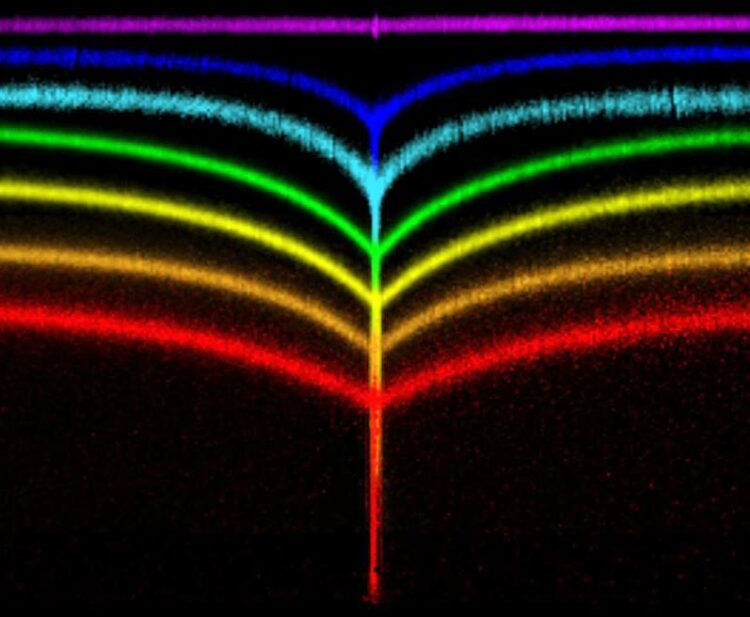The memory of folds

Folding of a soft material leaves behind a scar which serves as a nucleation point for subsequent folds
(c) Stefan Karpitschka
What happens when soft materials are compressed strongly? Researchers from the Max Planck Institute for Dynamic and Self-Organization, the University of Twente and Cornell University now revealed the morphology of creases created upon folding at micrometer scale. They revealed a dual folding mechanism driven by capillary forces, similar to wetting liquids, causing a T-shape folding profile. The unfolding leaves behind a scar which serves as a nucleation point for subsequent folds. Without damaging the material, it thereby enables a freely programmable folding memory of soft surfaces.
The principle of folding is part of our everyday lives: When closing your hand or bending your arm, a crease is formed, causing the skin to make self-contact which is reversed upon reverting the movement. On a microscopic scale, such folding is known to leave behind small scars which serve as initiation points for subsequent folds. Stefan Karpitschka, principal researcher of the study investigating such folds, explains: “So far, these scars have been considered to result from the reduction of surface tension that leads to adhesion if a soft surface contacts itself. We demonstrate that surface tension also plays an important role for the micro-morphology of creases, and that its reduction is not sufficient to explain the origin of the scars.”
Capillarity induces T-shapes folding profiles
To observe the behavior of solid materials upon folding, the researchers used a polymer gel which could be compressed in a defined manner. A layer of fluorescent probes at the surface of this gel enabled them to follow the crease formation on microscopic scale. Without surface tension, the material folded in a V-shaped profile. However, if the surface tension comes into plan, the balance of surface forces changes the morphology: At the upper edge of the self-contacted material a second fold emerges which overall results in a T-shaped profile of the crease.
Furthermore, this also induces a strong curvature of the free surface which defines the capillarity forces at the crease. “It has been observed previously that capillarity effects cannot only be observed in liquids, but are also found in soft solid materials” explains Karpitschka. “Here we illustrate that also surface contacts of solid materials show a capillary nature. This is the physical explanation for both the surface curvature and the T-shaped profile of the crease.”
Pre-defining folds by contact line pinning
Overall, these observations show that emerging scars in materials on the microscale are caused by pinning of the contact line upon unfolding the material. These scars therefore do not indicate a damage of the material but constitute the remains of self-adhesion after a fold. This causes an asymmetry in the folding and unfolding of materials, and defines the occurrence sites of subsequent creases.
“Our observations on crease morphology open a new route to quantify the mechanics on solid-solid interfaces” concludes Karpitschka. “Such a ‘folding memory’ might play an essential role in the formation of subcellular structures in biology, but also in the microscale manufacturing oft soft robotics or smart textiles.”
Originalpublikation:
Pinning-Induced Folding-Unfolding Asymmetry in Adhesive Creases
Phys. Rev. Lett. 127, 028001 – Published 9 July 2021
https://doi.org/10.1103/PhysRevLett.127.028001
Weitere Informationen:
https://journals.aps.org/prl/abstract/10.1103/PhysRevLett.127.028001
Media Contact
All latest news from the category: Materials Sciences
Materials management deals with the research, development, manufacturing and processing of raw and industrial materials. Key aspects here are biological and medical issues, which play an increasingly important role in this field.
innovations-report offers in-depth articles related to the development and application of materials and the structure and properties of new materials.
Newest articles

A universal framework for spatial biology
SpatialData is a freely accessible tool to unify and integrate data from different omics technologies accounting for spatial information, which can provide holistic insights into health and disease. Biological processes…

How complex biological processes arise
A $20 million grant from the U.S. National Science Foundation (NSF) will support the establishment and operation of the National Synthesis Center for Emergence in the Molecular and Cellular Sciences (NCEMS) at…

Airborne single-photon lidar system achieves high-resolution 3D imaging
Compact, low-power system opens doors for photon-efficient drone and satellite-based environmental monitoring and mapping. Researchers have developed a compact and lightweight single-photon airborne lidar system that can acquire high-resolution 3D…





















